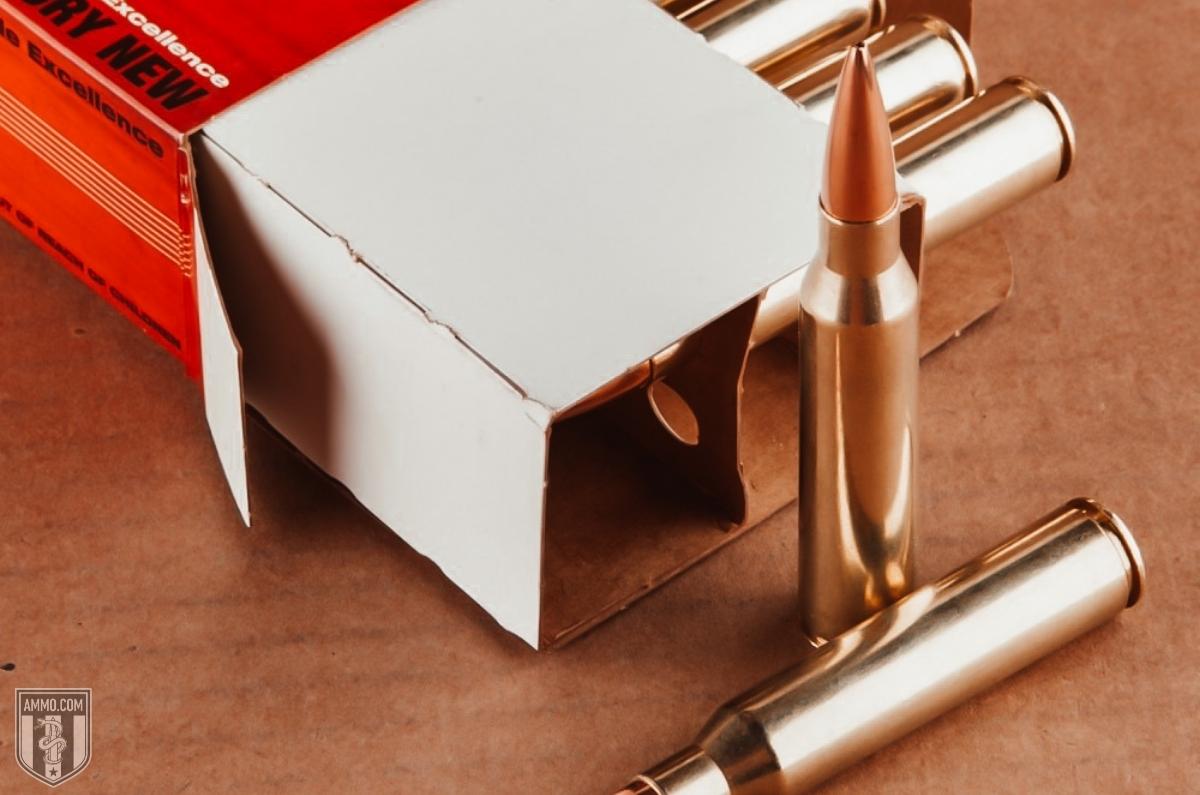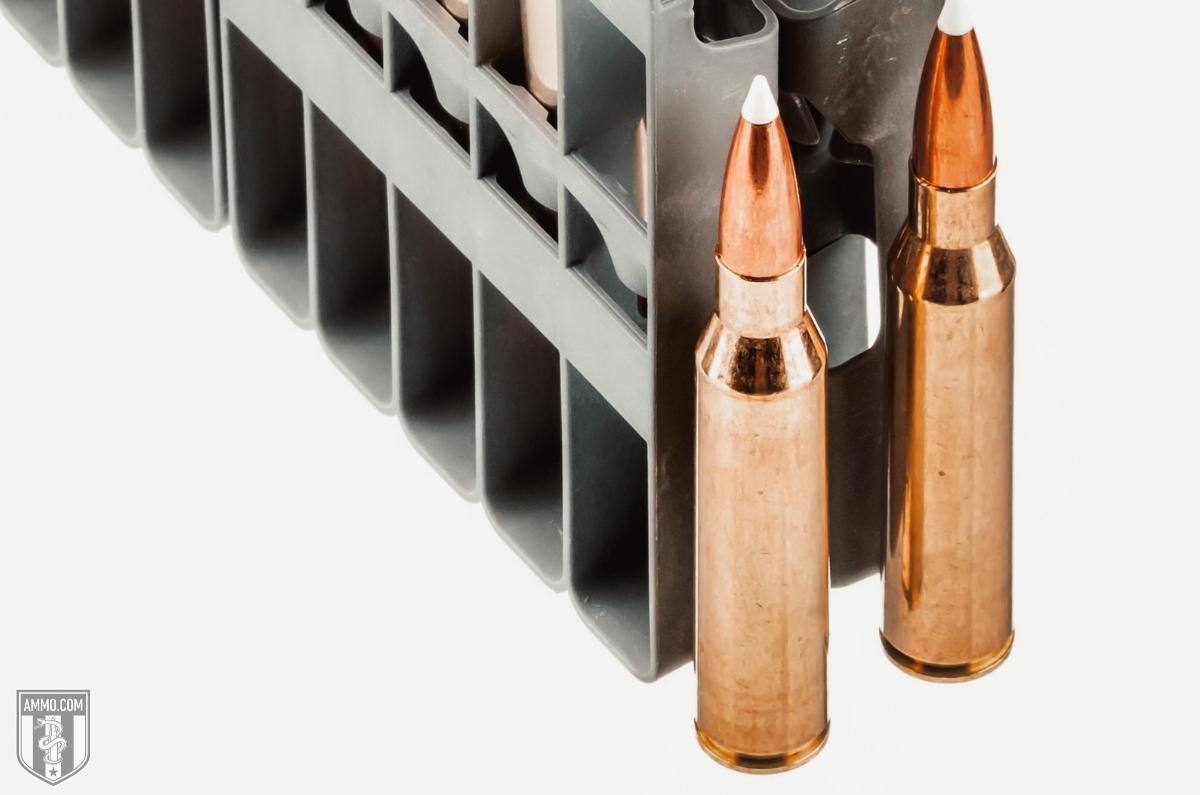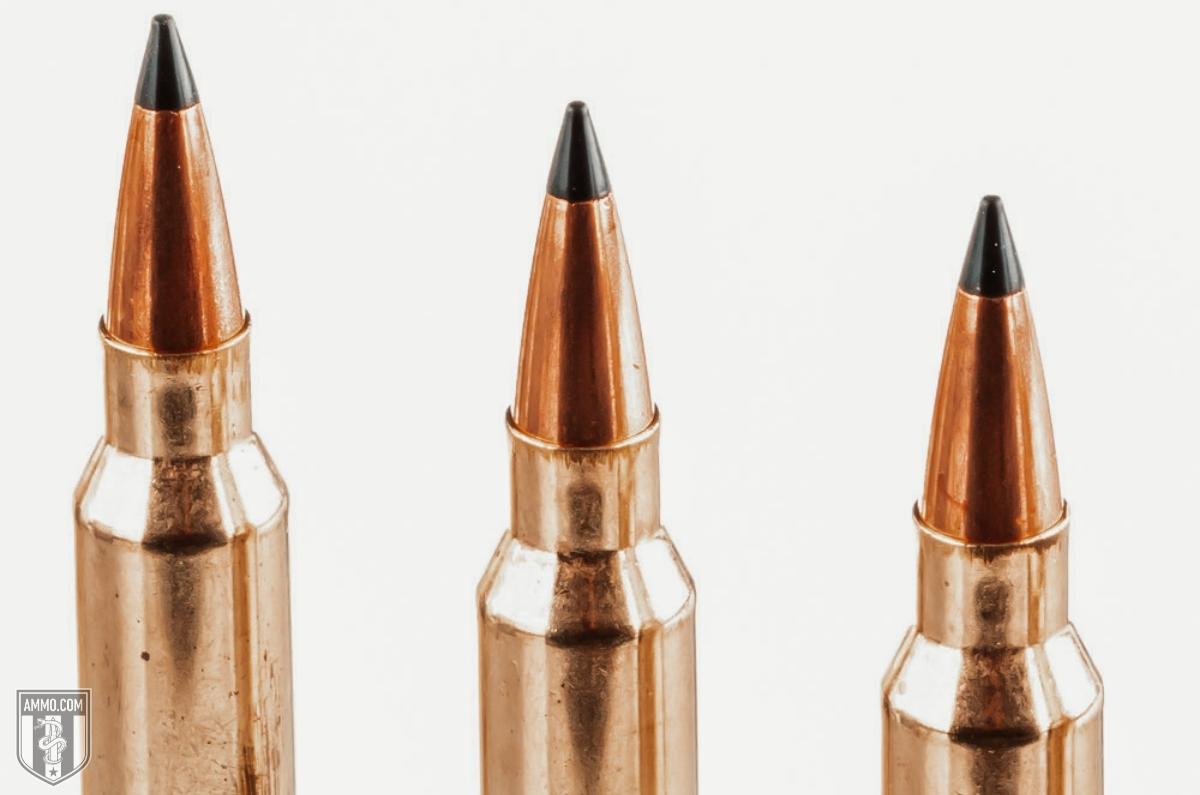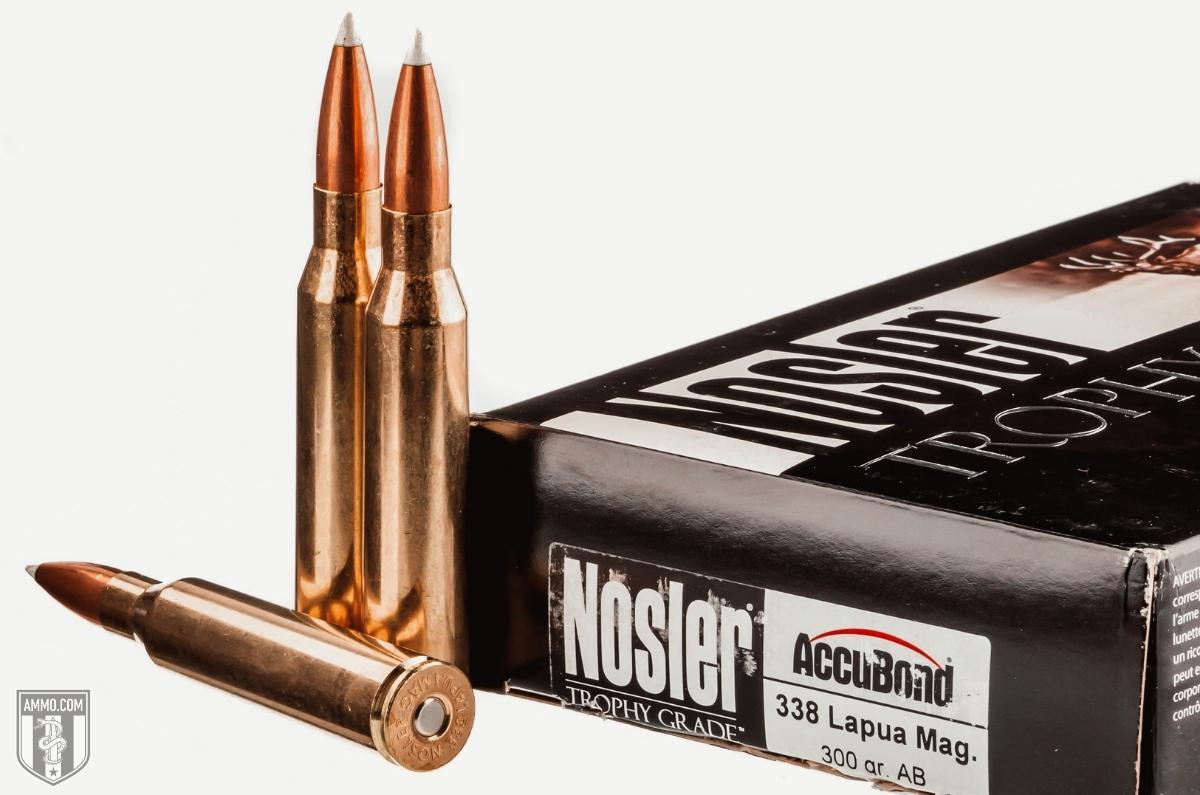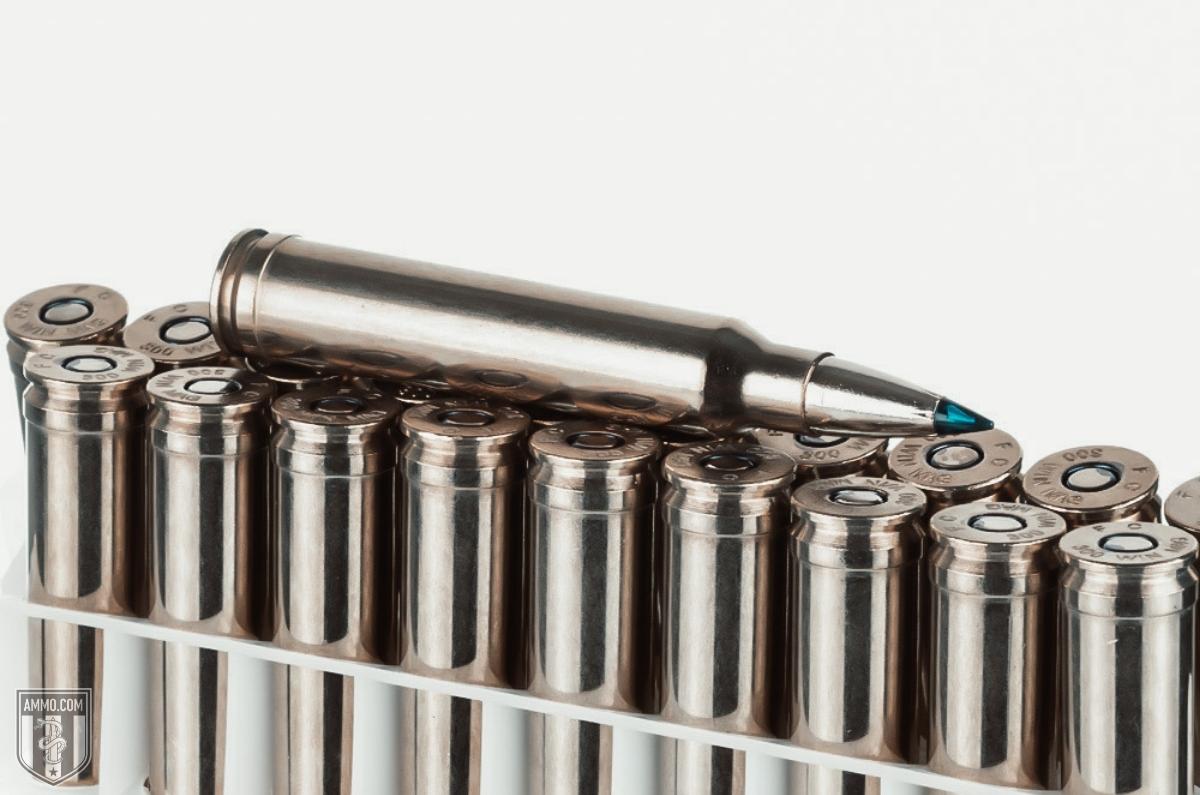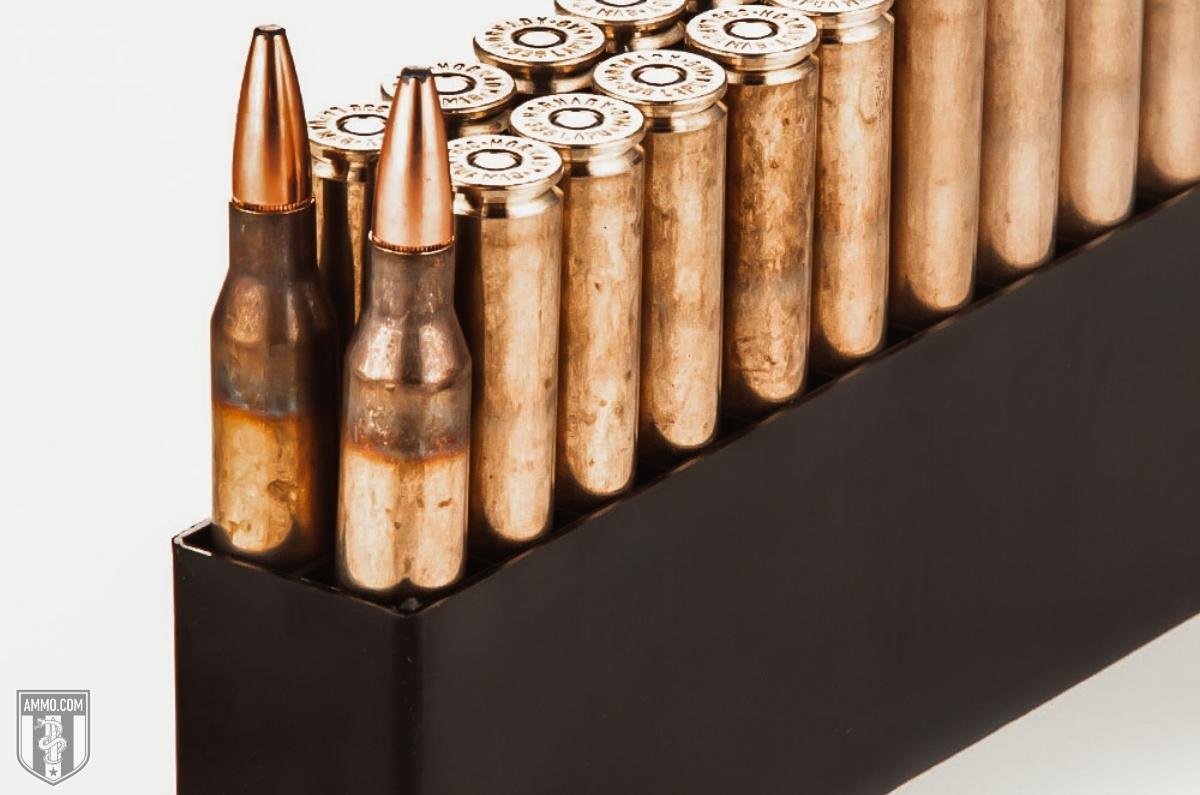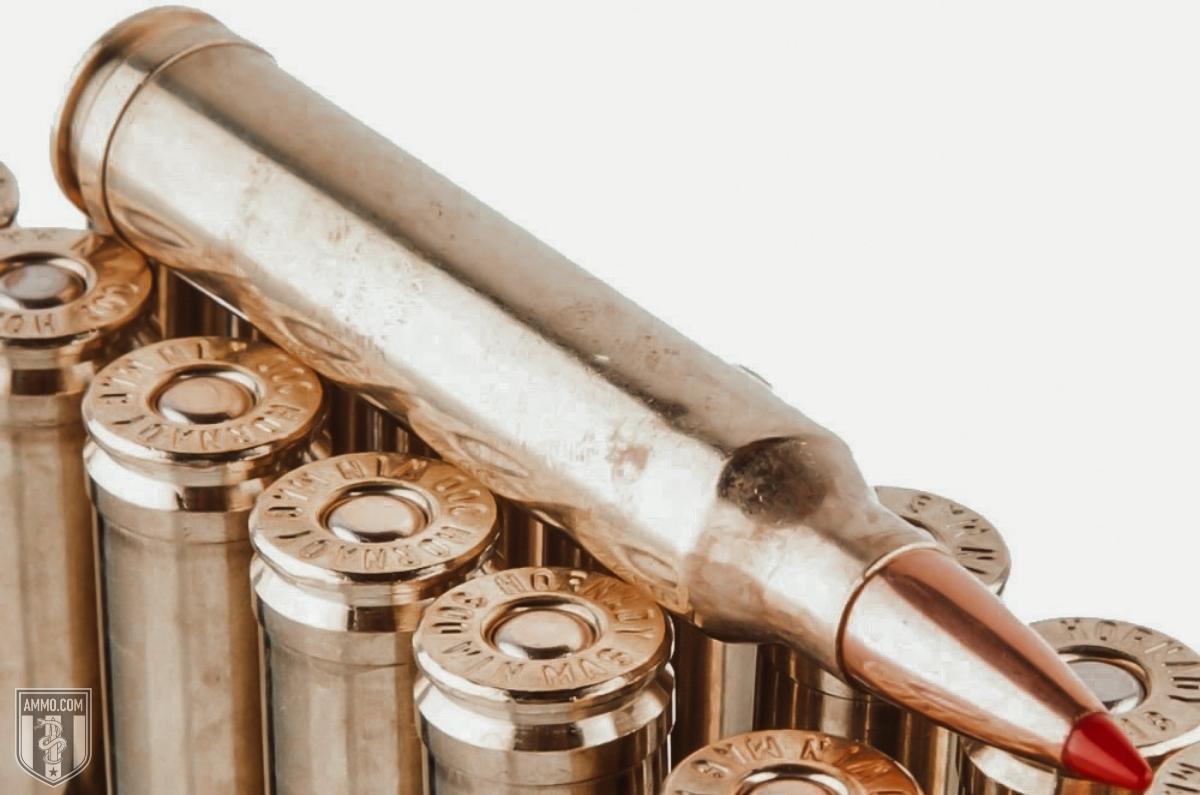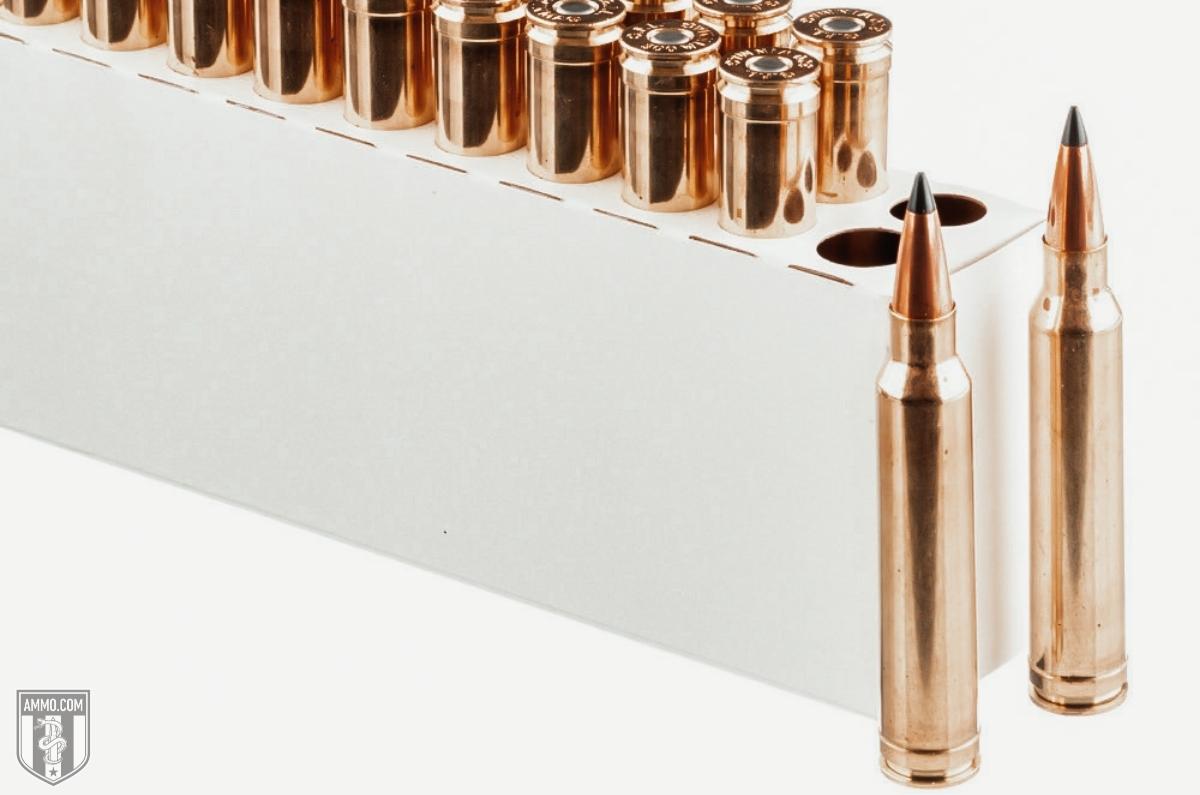300 Win Mag vs 338 Lapua: Clash of the Magnum Long Distance Titans
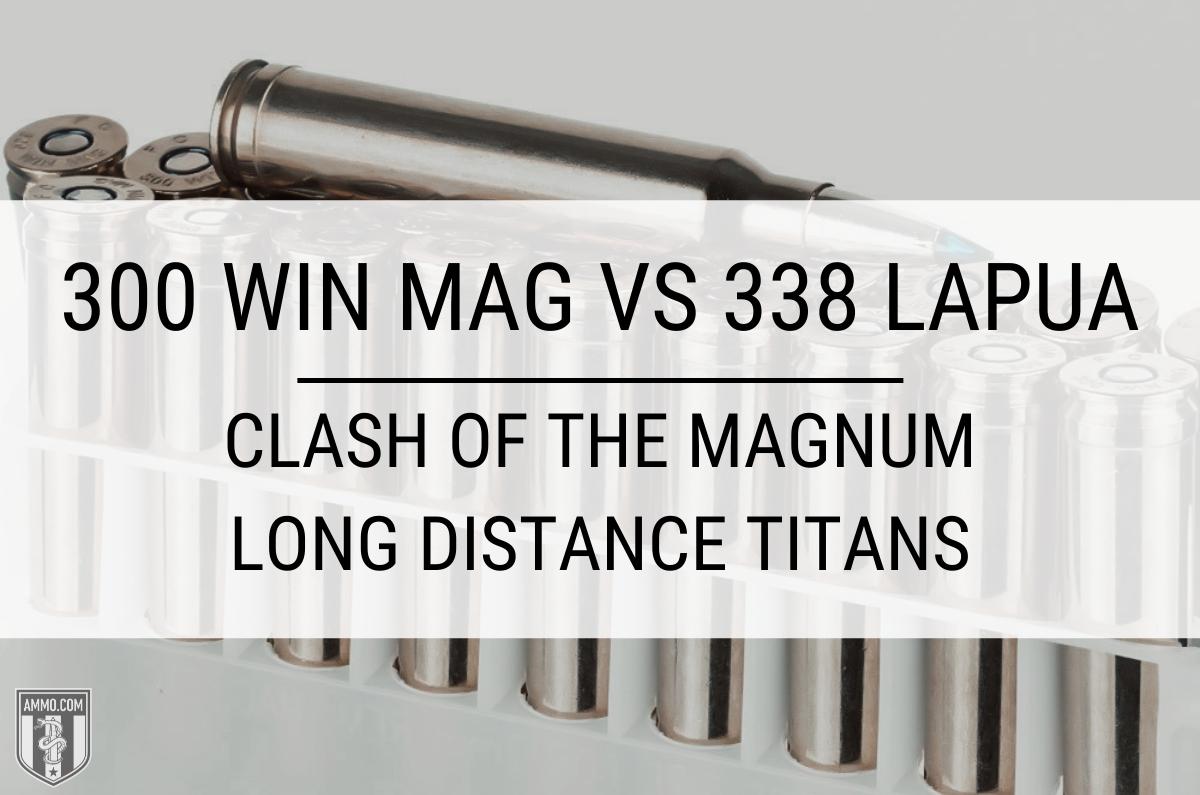 When it comes to long range shooting and big game hunting, two rifle cartridges that are always in the discussion are 300 Winchester Magnum and 338 Lapua Magnum.
When it comes to long range shooting and big game hunting, two rifle cartridges that are always in the discussion are 300 Winchester Magnum and 338 Lapua Magnum.
Both cartridges have an incredibly flat trajectory, exceptional terminal ballistics, and ridiculously high muzzle velocities making them excellent options for all your long range needs.
But how good are they really?
The Secret Service snipers atop 1600 Pennsylvania Avenue are locked and loaded with a Remington 700 action mounted in an Accuracy International chassis chambered in 300 Win Mag.
The #3 longest sniper shot on record was taken by Corporal Craig Harrison of the British Army in Afghanistan with a 338 Lapua at 2,707 yards.
If this isn’t enough of an endorsement, I’m not sure what is! However, does that mean that they are going to be ideal for your needs?
In this article, we will analyze the advantages and disadvantages of each cartridge to help you make a more informed decision on your new bolt action rifle purchase.
What is the Difference Between the 338 Lapua and 300 Win Mag?
The difference between 338 Lapua and 300 Win Mag is that the 338 Lapua fires a 0.338” diameter bullet and was developed for military snipers while the 300 Win Mag is a sporting cartridge that fires a 0.308” caliber bullet. Both cartridges are excellent for long range shooting.
The 338 Lapua Magnum and the 300 Winchester Magnum were developed with one goal in mind: long range shooting performance.
The 300 Win Mag was released in the 1960’s and has been a staple in the sporting community since its release. It has also seen military and law enforcement success as a clear upgrade to the 308 Winchester inn terms of trajectory, effective range, and kinetic energy at the cost of added recoil.
The 338 Lapua is a Child of the 80’s and was first designed as a military round developed to punch through military grade body armor at 1,000 yards. With an extremely long effective range, the 338 Lapua has successfully bridged the gap between 300 Win Mag and 50 BMG.
Although the 338 was designed to surpass the 300 Win Mag, they are more similar than you might think. Let’s find out how!
Cartridge Specs
When comparing precision rifle cartridges, it’s a good idea to compare the cartridge specs to gain more knowledge of each.
The first major difference that we see is that the 338 Lapua fires a larger caliber bullet (0.338” diameter) than the 300 Win Mag (0.308” diameter).
The 338 Lapua has a slightly longer case length and higher case capacity that allows it to fire significantly heavier bullets than the 300 Win Mag. Typical 338 factory ammo will be loaded with a 250-300 grain bullet, while the 300 Win Mag delivers righteous justice with bullet weights between 150 and 200 grains.
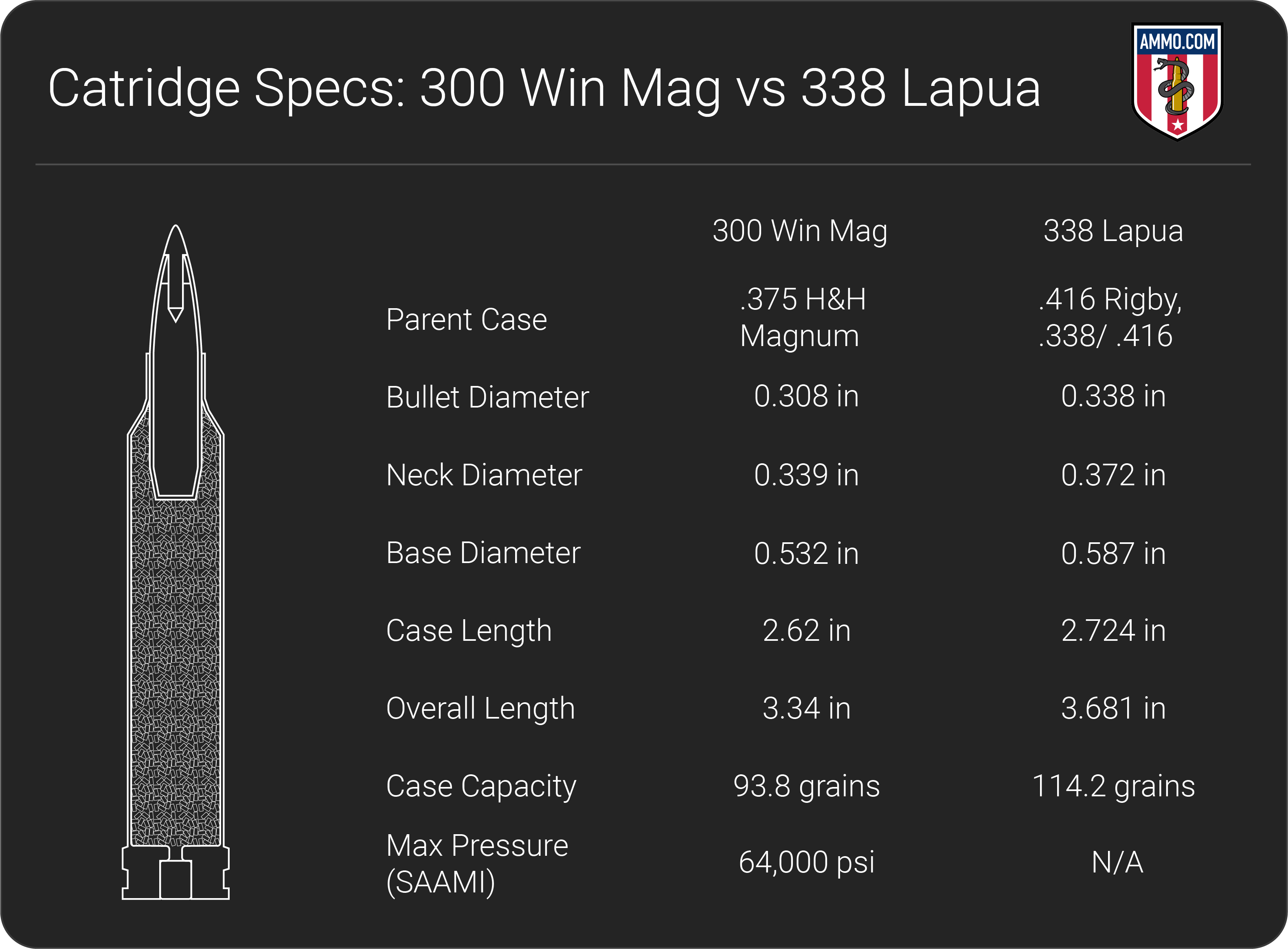
As the 338 Lapua Mag fires heavier bullets, you’ll discover that it outperforms the 300 Win Mag from a ballistics standpoint in almost every category.
However, recoil is not one of them…
Recoil
If you’ve ever pulled the trigger on a centerfire cartridge that has the name “magnum” at the end of it, then you’re well acquainted with recoil and what it can do.
Recoil is the energy directed towards the shooter when a cartridge is fired from a firearm. It is dependent on several factors, but firearm weight, powder charge, and bullet weight are three of the primary factors that affect felt recoil.
Many competitive shooters and big game hunters will not be concerned with recoil as any shooter can adapt to it with proper training and a concrete focus on the fundamentals of marksmanship.
However, for most shooters recoil will be a serious issue that they need to consider, as developing recoil anticipation is extremely detrimental to downrange accuracy. The major issue to consider is rifle weight, as most 338 Lapua Mag rifles are heavier than your average bolt action 300 Win Mag.
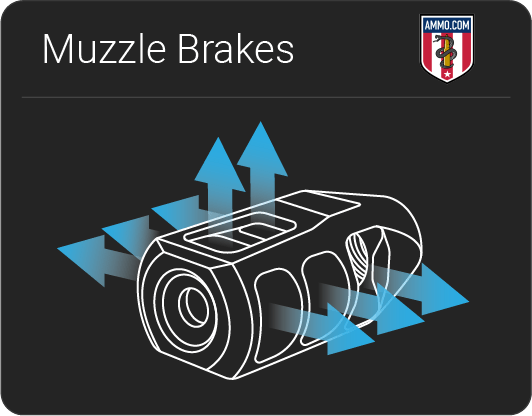
When you look at a tactical 338 rifle like a Barrett MRAD or Accuracy International L115A3, rifle weights are typically over 12 lbs. Conversely, most 300 Win Mag rifles are around 10 lbs as they need to lighter and more maneuverable for big game hunters stalking elk in the woods or mule deer on the plains.
The average felt recoil for a 338 Lapua in a 12 lb rifle will be around 38 ft-lbs of shoulder abuse, while a 10 lb 300 Winchester Magnum rifle will smack you around with an average of 25 ft-lbs of force. That’s a 50% difference!
One thing that many firearm manufacturers will do to help tame the recoil of the mighty magnums is install a factory muzzle brake, similar to the Ruger Precision Rifle. A muzzle brake works by redirecting gasses exiting the barrel to help push the rifle forward, thereby reducing the amount of recoil force directed towards the shooter.
However, no muzzle brake can entirely eliminate recoil, however, the 300 Win Mag will have considerably less recoil than the 338 Lapua.
Trajectory
Trajectory quantifies a bullet’s flight path as it travels downrange, measured in inches of bullet drop.
Both the 338 and 300 Win Mag were designed for Extreme Long Range (ELR) precision rifle shooting, as such they both have amazing trajectories.
The 338 Lapua has a flatter trajectory at distances over 1,000 yards, but the difference is not considerable. Under 1,000 yards, the two rifle cartridges are virtually identical.
For example, at the 1,000 yard-line the 338 Lapua as dropped -288” while the 300 Win Mag is at -296”. That’s not all that much difference at such a long distance.
The 338 Lapua Mag has a slightly flatter trajectory than the 300 Win Mag, but most precision rifle shooters and hunters will not be able to notice any appreciable difference between the two.
Ballistic Coefficient
Ballistic coefficient (BC) is a measure of how well a bullet resists wind drift and combats air resistance. Put another way, it’s a numeric representation of how aerodynamic a bullet is. A high BC is preferred as this means the bullet will buck the wind easier.
Generally, a heavier bullet will have a higher BC as it takes more force to disrupt the flight of a heavier bullet than a lighter one.
As the 338 Lapua has access to heavier bullets, it will generally have a higher BC compared to the 300 Win Mag.
On average over a wide sampling, the 338 Lapua has a BC of 0.654 while the 300 Win Mag has an average BC of 0.489.
Sectional Density
Sectional Density (SD) is the measure of how well a bullet penetrates a target. This is extremely important when hunting big game, as you need a bullet that can punch through thick hide, bone, and sinew.
Sectional density is calculated by comparing the bullet weight and the bullet diameter. The higher the SD the deeper the bullet will penetrate into the target.
On average, the 338 Lapua Magnum will have a higher SD than 300 Win Mag, meaning the 338 will penetrate deeper. The average SD’s for both rounds is 0.34 for the 338 compared to 0.28 for the 300 Win Mag.
However, do understand that SD is extremely bullet dependent. Take for example the Berger 210 gr VLD Hunting .308” diameter bullet that has a SD of 0.316. Or there is also the Barnes 220 gr Precision Match OTM with a SD of 0.331.
The 338 will have a higher SD but there are some specific factory loads for 300 Win Mag that close the gap considerably.
Hunting
When it comes to big game hunting in North America, the 300 Win Mag is clearly the ideal choice while the 338 Lapua Magnum will be the better option for African safari.
Now before all my 338 aficionados break out their torches and pitchforks, let me explain my reasoning.
When it comes to ethically harvesting any game animal, shot placement will take precedence over any other ballistic category. Because none of it matters if you can’t but the bullet where it needs to go, it won’t matter how many ft-lbs of muzzle energy you have or how much muzzle velocity your tricked out hunting rifle can produce if you can’t hit the target.
Shot placement is the difference between a clean harvest and wounding the poor beast.
And the truth is that most shooters are more accurate with a 300 Win Mag due to lower recoil than a 338 Lapua.
Better accuracy means more meat in the freezer, and that’s the goal of every hunter.
Now, I’m sure that many of my astute readers will note that the 338 has outperformed the 300 Win Mag in most all ballistic categories that we’ve discussed so far. So, if that’s the case, why wouldn’t hunters prefer to have all these advantages at their beck and call when the bull elk of a lifetime walks into their sights?
The simple answer is: At hunting ranges you won’t need them.
Let’s take a 500-yard hunting shot as our baseline for this ballistic discussion.
First, I would suggest that 500 yards will be the limit that most hunters will be comfortable taking a shot on a game animal. This is not an affront to their ability, but more so their maturity to know the limits of their skills.
A 500-yard shot into the vital organs of any game animal is an excellent feat of marksmanship as this requires MOA or sub-MOA levels of accuracy to achieve. For reference, 1 MOA = a 1” group at 100 yards. Therefore, at 500 yards that would mean 1 MOA = a 5” group.
Next, let’s look at the ft-lbs of kinetic energy each round has at 500 yards. The 338 is just blasting away with approximately 2640 ft-lbs of punishment while the 300 Win Mag is at a respectable 1740 ft-lbs of force.
The general rule of hunting is that you need 1,000 ft-lbs of force to harvest a whitetail or mule deer and 1,500 ft-lbs of force to harvest an elk.
Is that elk at 500 yards going to be able to tell the difference between 2,600 ft-lbs and 1,700 ft-lbs of energy? I sincerely doubt it.
The 338 Lapua is simply not needed for ethical hunting ranges found in North America, or to put it another way, “Don’t use a cannon to kill a mosquito.”
Another aspect to consider is the weight of your hunting rifle, and 300 Win Mag rifles are generally lighter than 338 Lapua rifles. This is primarily due to the heavier action needed to handle a 338 Lapua and to help mitigate recoil.
For example, your average Barrett MRAD chambered in 338 Lapua will weigh over 14 lbs without a scope or bipod. That’s a heavy rifle to be carrying around in the bush all day when you could be carrying a lightweight Weatherby Vanguard or Ruger Hawkeye tipping the scales right around 8 lbs in comparison.
Looking at all of these factors, it’s clear that a 300 Win Mag is more than enough to handle any game animal in North America and provide an enjoyable hunting experience as well.
However, if your sights are set on something a bit bigger like an elephant, Cape Buffalo, or Rhino, then the 338 Lapua is a good option for these game animals. For these massive mammals, you will need the additional energy and penetration to ensure a clean kill and prevent the animal from undue suffering.
Many African hunters will prefer a dedicated elephant round such as the 458 Lott, 416 Remington, or 500 Nitro Express, however the 338 Lapua will get the job done in a pinch if necessary.
Ammo and Rifle Cost/Availability
One aspect that we did not discuss in the hunting section was cost per round. Typically, hunters are less concerned about price as they are only going through about 1-2 boxes of ammo during hunting season anyway.
However, for long range shooting competitors, price is a big deal of they plan to shoot factory ammo.
On average, you should expect to pay no less than $5/round for 338 Lapua Magnum practice ammo, although deals can be had if you can afford to buy in bulk. Premium hunting ammo for 338 will typically run $8/round and up.
Compare that to $2/round for cheap FMJ 300 Win Mag ammo and about $5/round for the really good hunting quality ammo.
The 300 Win Mag is easier to find in your local firearms shop or hunting outlet store, whereas 338 Lapua is a lot less common to find in these stores.
Furthermore, there are considerably more varieties of 300 Win Mag available since it has been on the market longer and has seen widespread commercial success for sporting purposes. The 338 Lapua is still primarily considered a military round and has not seen its popularity rise in the hunting community as much as 300 Win Mag has.
In terms of rifles and options, you cannot beat the cost and configurations available for 300 Win Mag bolt action rifles.
Virtually every rifle manufacturer has an option in 300 Win Mag. Rifles like the Remington 700, Savage Hunter 110, Weatherby Vanguard, Ruger American, and Browning X-Bolt.
Several of these rifles can be had for under $800 given current market conditions at the time of writing.
On the other hand, if you want a new 338 Lapua rifle, you should expect to pay no less than $1,100 and up. There are also fewer rifle options for 338 available as it is less popular with civilian shooters.
Reloading
One way to mitigate the ridiculous cost of shooting 338 Lapua is by reloading your own ammo. Reloading, or handloading, is the process of reforming fired brass cases and replacing the spent components (gunpowder, primer, and bullet) so that the case can be fired again.
This allows reloaders to purchase components in bulk to reduce their overall cost basis per round. Furthermore, it allows them to customize their ammo to achieve extreme levels of consistency and accuracy with their handloads.
Reloading is a rewarding process as it allows you to shoot for cheaper or, what typically happens, shoot more for the same overall cost.
The only downside to reloading 338 Lapua is the lack of bullet cross-compatibility with other cartridges. Some .338 caliber cartridges include: 338 Federal, 338 Win Mag, 338 Rem Ultra Mag, and 340 Weatherby Magnum.
On the other hand, reloading for 300 Win Mag allows for significant bullet cross-over with other extremely popular cartridges. Some of these popular 0.308 caliber cartridges include: 308 Winchester, 30-06 Springfield, 300 WSM, 30 Nosler, 300 Remington Ultra Mag, and even the newer 300 PRC.
All the major bullet manufacturers (like Hornady, Berger, Barnes, and Nosler) offer multiple options in 0.308” and 0.338” diameter bullets to construct your perfect reload.
Ballistics
Our experts here at Ammo.com have put together extensive ballistics tables for both the 300 Win Mag and 338 Lapua. These tables will compare popular bullet weights to muzzle velocity, muzzle energy, and trajectory out to 400 yards.
We’ve combed the internet for multiple manufacturer’s published data, so you don’t have to! Check them out below.
.300 Win Magnum Ballistics
Note: This information comes from the manufacturer and is for informational purposes only. The actual ballistics obtained with your firearm can vary considerably from the advertised ballistics. Also, ballistics can vary from lot to lot with the same brand and type load.
| 300 Win Magnum Bullet WEIGHT | Muzzle VELOCITY (fps) | Muzzle ENERGY (ft. lbs.) | TRAJECTORY (in.) | |||||||||||
|---|---|---|---|---|---|---|---|---|---|---|---|---|---|---|
| Muzzle | 100 yds. | 200 yds. | 300 yds. | 400 yds. | Muzzle | 100 yds. | 200 yds. | 300 yds. | 400 yds. | 100 yds. | 200 yds. | 300 yds. | 400 yds. | |
| 150 Grain | 3290 | 2951 | 2636 | 2342 | 2068 | 3605 | 2900 | 2314 | 1827 | 1424 | 2.5 | 1.9 | -3.8 | -15.8 |
| 150 Grain Superformance | 3400 | 3150 | 2914 | 2690 | 2477 | 3850 | 3304 | 2817 | 2409 | 2043 | 1 | 0 | -5.1 | -15 |
| 165 Grain | 3100 | 2877 | 2665 | 2462 | 2269 | 3522 | 3033 | 2603 | 2221 | 1897 | 2.5 | 2.4 | -3 | -16.9 |
| 178 Grain | 2900 | 2760 | 2568 | 2375 | 2191 | 3509 | 3030 | 2606 | 2230 | 1897 | 2.5 | 1.4 | -5 | -17.6 |
| 178 Grain | 2960 | 2770 | 2588 | 2413 | 2245 | 3463 | 3032 | 2647 | 2301 | 1992 | 1.5 | 0 | -6.7 | -19.4 |
| 178 Grain Super Match | 2960 | 2770 | 2587 | 2412 | 2243 | 3462 | 3031 | 2645 | 2298 | 1988 | 1.5 | 0 | -6.7 | -19.4 |
| 180 Grain | 2960 | 2745 | 2540 | 2344 | 2157 | 3501 | 3011 | 2578 | 2196 | 1859 | 2.5 | 1.2 | -5.5 | -18.5 |
| 180 Grain Superformance | 3130 | 2927 | 2732 | 2546 | 2366 | 3917 | 3424 | 2983 | 2589 | 2238 | 1.3 | 0 | -5.9 | -17.3 |
| 190 Grain | 2885 | 1691 | 2506 | 2327 | 2156 | 3511 | 3055 | 2648 | 2285 | 1961 | 2.5 | 1.2 | -5.7 | -19 |
| 200 Grain | 2825 | 2595 | 2376 | 2167 | 1970 | 3545 | 2991 | 2508 | 2086 | 1742 | -2.5 | 1.6 | -4.7 | -17.2 |
| 220 Grain | 2680 | 2448 | 2228 | 2020 | 1823 | 3508 | 2927 | 2424 | 1993 | 1623 | 2.5 | 0 | -9.5 | -27.5 |
338 Lapua Mag Ballistics
Note: This information comes from the manufacturer and is for informational purposes only. The actual ballistics obtained with your firearm can vary considerably from the advertised ballistics. Also, ballistics can vary from lot to lot with the same brand and type load.
| 338 Lapua Magnum Bullet WEIGHT | Muzzle VELOCITY (fps) | Muzzle ENERGY (ft. lbs.) | TRAJECTORY (in.) | |||||||||||
|---|---|---|---|---|---|---|---|---|---|---|---|---|---|---|
| Muzzle | 100 yds. | 200 yds. | 300 yds. | 400 yds. | Muzzle | 100 yds. | 200 yds. | 300 yds. | 400 yds. | 100 yds. | 200 yds. | 300 yds. | 400 yds. | |
| 250 Grain | 2900 | 2685 | 2481 | 2285 | 2098 | 4668 | 4002 | 2416 | 2899 | 2444 | 1.7 | 0 | -7.3 | -21.3 |
| 250 Grain | 2963 | 2795 | 2640 | 2493 | n/a | 4842 | 4341 | 3881 | 3458 | n/a | 1.9 | 0 | -7.9 | 0 |
| 250 Grain Match | 2900 | 2760 | 2625 | 2494 | 2366 | 4668 | 4229 | 3825 | 3452 | 3108 | 1.5 | 0 | -6.6 | -18.8 |
| 285 Grain | 2745 | 2616 | 2491 | 2369 | 2251 | 4768 | 4331 | 3926 | 3552 | 3206 | 1.8 | 0 | -7.4 | -21 |
| 285 Grain Match | 2745 | 2623 | 2504 | 2388 | 2275 | 4768 | 4352 | 3966 | 3608 | 3275 | 1.8 | 0 | -7.3 | -20.8 |
| 300 Grain | 2660 | 2544 | 2432 | 2322 | n/a | 4715 | 4313 | 3940 | 3592 | n/a | 1.9 | 0 | -7.8 | n/a |
300 Win Mag: A Brief History of America’s Magnum Long Distance Cartridge
In 1958, Winchester figured they should probably get in on the magnum craze and introduced 3 new cartridges to their line: the 264 Winchester Magnum, the 338 Win Mag, and the 458 Winchester Magnum.
Notice any glaring omission from that list? There’s no 30-caliber option!
Wildcatters (hand loaders who take it upon themselves to develop new cartridges) quickly jumped on this glaring hole in the Winchester line and developed the 30-338 Winchester. The 30-338 Winchester was simply a 338 Win Mag case necked down to accept a 30-claiber bullet. Furthermore, competitor Norma Precision also took the opportunity to get in on the action and developed the 308 Norma Magnum in 1960.
It was at this point that Winchester figured that maybe they might do well by introducing a 30-caliber magnum rifle cartridge offering. And in 1963, Winchester introduced the 300 Win Mag in its long-action Winchester Model 70 bolt action rifle.
Remington quickly followed suit, introducing a 300 Win Mag offering in its popular Rem 700 bolt action rife. Since then, the 300 Winchester Magnum has quickly become one of the most successful magnum rifle cartridges on the market today.
The 300 Winchester Magnum was developed from the belted 375 H&H Magnum cartridge and sports a whopping case capacity of 91.5 gr of water and a max pressure of 64,000 psi based on SAAMI specifications.
This voluminous case capacity allows the 300 Win Mag to pack in the powder and push the .308” diameter bullet to its limits.
At the muzzle, a 150-grain bullet is screaming down range at about 3300 fps with a back-breaking 3600 ft-lbs of energy. That is some serious power! Standard loadings for the 300 Win Mag range between bullet weights of 150 and 220 gr.
Many shooters believe that the belt around the case head is required to contain the “case-splitting” pressure that the 300 Win Mag must exude. However, this is a common misconception.
Based on the case design, the belted cartridge is superfluous. However, Winchester retained the designed as a marketing strategy to link the cartridge to its heavy hitting predecessor, the 375 H&H Magnum.
The strategy was wildly successful as the 300 Winchester Magnum has become one of the most popular magnum cartridges on the market, surpassing the 300 WSM, 7mm Rem Mag, and 270 Weatherby Magnum in popularity.
To learn more about how 300 Win Mag compares to other cartridges, make sure to check out our additional caliber comparisons:
338 Lapua: A Brief History of the 50 BMG Lite
Development of the 338 Lapua Mag began in 1983 by US-based company, Research Armament Industries (RAI). Their goal was to create a cartridge that bridged the gap between the 300 Winchester Magnum and the 50 BMG.
The design specification required that the cartridge be able to penetrate 5 layers of military-grade body armor at 1000 meters and fire a 0.338” diameter bullet for its ideal sectional density and ballistic coefficient. The targeted muzzle velocity to meet these goals was 3,000 fps.
Initial designs for the 338 Lapua Magnum utilized the 416 Rigby as a parent case, simply necking it down to accept a 250 grain Hornady A-MAX bullet. Sadly, the 416 Rigby case was not strong enough to withstand the pressures needed to achieve RAI’s ballistic goals.
By 1984, RAI was under pressure from the military to finish their work and in desperation they reached out to the Finnish ammo company, Lapua, for assistance. Straddled with debt, RAI had to drop out of the program, and this left the fate of the new cartridge in the hands of the engineers at Lapua.
The ballistics team at Lapua joined forces with Sako and Accuracy International to work on redesigning the 416/338 case so that it could handle 60,000 psi of pressure.
The final case design was an extremely pressure resistant that was able to achieve velocities just short of the initial 3,000 fps goal. The decision was also made to depart from Hornady bullets, utilizing a new bullet design instead, the LockBase B408 FMJ.
The finalized 338 Lapua Magnum cartridge submitted and accepted by the CIP (the European version of SAAMI) in 1989 and became a NATO cartridge shortly thereafter.
NATO standard 338 Lapua Mag ammo fires a 250 grain bullet with a muzzle velocity of 3000 fps and muzzle energy of 4892 ft-lbs.
Precision rifle shooters who like to air it out to 1000 yards or more will appreciate the 338’s ability to easily remain supersonic past 1400 yards and maintain MOA levels of accuracy. While the 338 Lapua has a trajectory that would make any 6.5 Creedmoor or 300 Win Mag shooter green with.
The 338 Lapua Mag is a powerhouse of a round and will be competing with the 50 BMG for years to come.
To learn more about how 338 Lapua compares to other cartridges, make sure to check out our additional caliber comparisons:
Final Shots: 338 Lapua vs 300 Win Mag
When you need a hard hitting magnum rifle cartridge that can really reach out and touch something, the 300 Winchester Magnum and 338 Lapua Magnum are ready to answer the call.
The 338 Lapua Magnum is a cartridge that was specifically designed for military sniper rifles like the Barrett MRAD and Accuracy International L115A3. It is a massive, punishing, long distance sniping round that can punch through military-grade body armor at 1,000 yards and remain combat effective well past 1,500 yards. The 338 has an incredibly flat trajectory but at the cost of extremely high recoil that is difficult to control for a novice shooter.
The 300 Winchester Magnum is a belted-magnum cartridge that has survived the test of time. Whether it be on the battlefield, the concrete jungle, precision long range shooting competitions, or in the woods, the 300 Win Mag will get the job done provided you do your part. With powerful muzzle energy and an effective range near 1,300 yards, the 300 Win Mag has made a name for itself as a long range shooting powerhouse.
But which cartridge is the better choice for you?
For most shooters, the 300 Win Mag will be more than enough.
With less recoil, lower cost per round, similar trajectory to the 338 Lapua, and more ammo and rifle availability, the 300 Win Mag is the obvious choice for most hunters and precision shooters.
Does that mean you shouldn’t get a 338 or you should sell the one you already have? Absolutely NOT!
If you love your 338 and can afford to feed it, then there’s no reason to let it go. This is the beauty of the Second Amendment, need plays no part in it.
Ammo Comparisons
- .308 vs 5.56
- 6.5 Creedmoor vs .308
- .300 Blackout vs .308
- .300 Win Mag vs .308
- .243 vs .308
- .308 vs .30-06
- 7mm-08 vs .308
- .270 vs .308
- 7.62x39 vs .308
- .223 vs .308
- .338 Lapua vs .308
- .380 ACP vs 9mm
- .223 vs 5.56
- .300 Blackout vs 5.56
- 9mm vs 45 ACP
- 9mm vs 40 S&W
- .357 SIG vs 9mm
- 10mm vs 9mm
- 9mm vs 9mm Luger
- .243 vs .270
- .300 Win Mag vs .30-06
- .270 vs .30-06
- .40 vs .45
- 38 Special vs 357
- 9mm vs 40 vs 45
- 5.56 vs 7.62x39
- 338 Lapua vs .30-06
- .30-30 vs .30-06
- 300 PRC vs 338 Lapua
- .30-06 vs 7mm
- 300 Win Mag vs 338 Lapua
- 300 PRC vs 300 Win Mag
- 300 WSM vs 300 Win Mag
- 338 Win Mag vs 338 Lapua
- 12 Gauge vs 20 Gauge
- 10mm vs 357 Mag
- .30-30 vs 7.62x39
- 224 Valkyrie vs 22-250
- 17 HMR vs 22 Mag
- 7.62x39 vs .300 Blackout
- 45 ACP vs 45 Auto
- 45-70 vs 30-30
- 300 Blackout vs 223
- 357 Magnum vs 9mm
- 350 Legend vs 300 Blackout
- 224 Valkyrie vs 223
- 45 ACP vs 38 Super
- 6.5 Grendel vs .308
- 17 HMR vs 22 LR
- 10 Gauge vs 12 Gauge
- 22-250 vs 223
- 45 Colt vs 45 ACP
- 350 Legend vs 30-30
- 5.7x28 vs 223
- 5.7 vs 9mm
- 5.56 vs 5.7
- 22 vs 9mm
- Buckshot vs Birdshot
- 450 Bushmaster vs 308
- 450 Bushmaster vs 223
- Buckshot vs Slug
- 6.5 Grendel vs 5.56 vs 223
- 6mm ARC vs 6.5 Grendel
- 44 vs 45
- 458 SOCOM vs 5.56
- 357 vs 44
- 32 ACP vs 380
- 300 Win Mag vs 338 Win Mag vs 338 Lapua Mag
- 450 Bushmaster vs 458 SOCOM vs 50 Beowulf
- 6mm Creedmoor vs 6.5 Creedmoor
- TMJ vs FMJ
- 44 Special Vs 44 Magnum
- 45 90 vs 45 70
- 6.8 Western vs 6.8 SPC
- 50 Beowulf vs 50 BMG
- 26 Nosler vs 6.5 PRC
- 28 Gauge vs 410
- 6.8 SPC vs 5.56
- 6.8 SPC vs 6.5 Grendel
- 6.8 Western vs 7mm Rem Mag vs .28 Nosler
- 6.8 Western vs 6.5 Creedmoor
- 22 Hornet vs 223
- 6.8 Western vs 6.5 PRC
- .410 vs 12 Gauge
- .410 vs 20 Gauge
- 22 LR vs 22 Mag
- 6mm ARC vs 243
- 7mm-08 vs 270
- 243 vs 6.5 Creedmoor
- Nickel vs Brass Casing
- 204 Ruger vs 223
- 50 Beowulf vs 5.56
- 260 Remington vs 6.5 Creedmoor
- 6mm Remington vs 243
- 28 Nosler vs 300 PRC
- 50 Beowulf vs 50 AE
- 22 Nosler vs 22-250
- 450 Marlin vs 45-70
- 300 Win Mag vs 300 Norma
- 458 SOCOM vs 300 Blackout
- 38-55 vs 45-70
- 22 Hornet vs 22 LR
- 300 Norma vs 338 Lapua
- 338 Lapua vs 50 BMG
- 28 Nosler vs 300 Win Mag
- 28 Nosler vs 6.5 Creedmoor
- 204 vs 22-250
- 458 SOCOM vs 45 70
- 44 40 vs 45 70
- 6.8 SPC vs 6.5 Creedmoor
- 450 Bushmaster vs 30-06
- 7mm Rem Mag vs 300 Win Mag
- 30 Carbine vs 223
- 25-06 vs 30-06
- 26 Nosler vs 28 Nosler
- 16ga vs 12ga
- 30 06 vs 7.62 x54R
- 9mm Makarov vs 9mm Luger
- 350 Legend vs 223
- 30 Carbine vs 5.56
- 6.5x55 vs 6.5 Creedmoor
- 6.5 Creedmoor vs 270 vs 25-06
- M193 vs M855
- 450 Bushmaster vs 458 SOCOM
- 6.5 Grendel vs 6.5 Creedmoor
- 350 Legend vs 5.56
- .277 Fury vs 6.8 SPC
- 277 Fury vs 300 Win Mag
- 10mm vs .45 ACP
- 277 Fury vs 223
- 6.8 SPC vs 300 Blackout
- 6.5 PRC vs 6.5 Creedmoor
- 277 Fury vs 308
- 277 Fury vs 6.5 Creedmoor
- 350 Legend vs 450 Bushmaster
- 277 Fury Vs 5.56 NATO
- 10mm vs 40S&W
- 32 ACP vs 9mm
- 32 Special vs 9mm
- 8.6 Blackout vs 300 Blackout
- 30 Super Carry vs. 9mm
- 5.56 vs 9mm
- .50 Action Express vs 9mm
- 7.62x25 vs. 9mm
- 10mm vs 44 Magnum
- 300 Blackout vs 300 Win Mag
- 6.5 Grendel vs 300 Blackout
- 460 Rowland vs 10mm
- 300 RUM vs 300 PRC
- 300 Norma vs 300 PRC
- 45 GAP vs 45 ACP
- 7mm PRC vs 300 Win Mag
- 300 PRC vs 6.5 Creedmoor
- 300 PRC vs 308
- 357 SIG vs 357 Mag
- 7.62x39 vs 7.62x51
- 243 Win vs 223 Rem
- 30 Nosler vs 300 PRC
- 6.5 Creedmoor vs. 30-06 Springfield
- 450 S&W vs. 44 Magnum
- 6.5 Creedmoor vs. 300 Win Mag
- 454 Cassull vs. 45-70 Govt
- 454 Cassull vs. 44 Mag
- 7.62x54r vs. 308 Winchester
- 22 ARC vs. 223 Rem
- Subsonic vs. Supersonic Ammo
